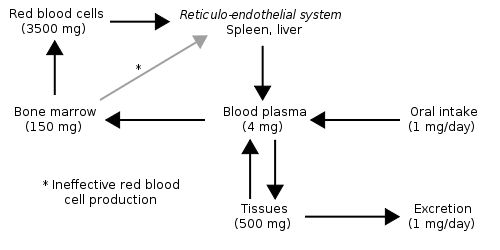The liver is the second largest organ in the body and has a variety of important functions relating to metabolism and detoxification. Information on the anatomy of the liver can be found here.
This article shall consider the important storage functions of the liver and relevant clinical conditions.
Carbohydrate Storage
The liver plays a central role in maintaining blood glucose levels. Following consumption of food, excess glucose can be stored within the liver as glycogen. This is stimulated by insulin release. Around 100g of glycogen is stored in the liver (300g is stored in skeletal muscle). The synthesis of glycogen occurs in the following steps:
- Glucose is converted to Glucose-6-P by glucokinase (hexokinase in skeletal muscle)
- Glucose-6-P is converted to Glucose-1-P by phosphoglucomutase
- Glucose-1-P is then converted to UDP-Glucose
- Finally UDP-glucose is added to the glycogen chain within the liver either by glycogen synthase or branching enzyme
Vitamin Storage
Lipid-soluble vitamins A,D,E,K , are stored in the liver, as is Vitamin B12.
Vitamin A
Vitamin A is stored within stellate cells in the liver as retinyl ester. The active form, retinol, is converted to this by lecithin:retinol acyltransferase. This provides an easily retrievable source of Vitamin A and regulates its availability for other pathways.
Vitamin A may be stored or removed from storage several times a day, regulating the amount in circulation and preventing damage that may occur as a result of excess. This process is known as retinol recycling.
The functions of Vitamin A include:
- Formation of the photoreceptor rhodopsin
- Signalling molecule within gene transcription
- Normal function of the immune system
- Mobilisation of iron stores for red blood cell production
Vitamin D
Vitamin D can either be produced in the body (cholecalciferol) or found in food (ergocalciferol). It must be metabolised in the liver before becoming the active form. Functions of Vitamin D include:
- Maintaining normal serum calcium and phosphate concentrations
- Increased absorption of calcium in the kidneys and intestines
- Increased mobilisation of calcium from bone , activating osteoclasts to release more calcium
Vitamin E
Vitamin E is a family containing various chemicals, including anti-oxidants. It can be stored in either the liver or adipose tissue. Functions include:
- Antioxidant
- Preventing propagation of free radicals
- Protects Vitamin A
Vitamin K
There are two forms of Vitamin K depending on whether they are obtained from plant or meat sources. The functions of Vitamin K include:
- Important for synthesis of clotting factors II, VII, IX and X.
- Co-factor for enzymes
Vitamin B12
Vitamin B12, cobalamin, is typically found within animal products. Around 2-5mg is stored in the body, with around 50% of this being in the liver. Functions of Vitamin B12 include:
- Production of DNA and RNA
- Maintaining healthy neurones
- Red blood cell production – alongside Vitamin B9
Mineral Storage
Iron and copper minerals are stored in the liver.
Iron
Iron levels within the body need to be tightly regulated. Therefore, excess amounts must be stored in places such as the liver. Most iron within cells is stored in ferritin, a protein produced by the liver. All cell types within the liver can store iron however the majority is stored within hepatocytes.
In severe iron overload the ferritin storage becomes saturated and so excess becomes stored within haemosiderin. However haemosiderin is a large, insoluble complex and iron stored within it is difficult to mobilise effectively.
Please see our article on iron metabolism for further detail.

Fig 1 – Diagram showing iron metabolism.
Clinical Relevance – Glycogen storage diseases
Patients with an inherited deficiency in an enzyme involved in the glycogenolysis pathway may experience episodes of hypoglycaemia. Cori disease (glycogen debranching enzyme deficiency) and Von Gierke disease (glucose-6-phosphate enzyme deficiency) are types of glycogen storage diseases. Children may present with an enlarged liver, due to excessive glycogen storage.
